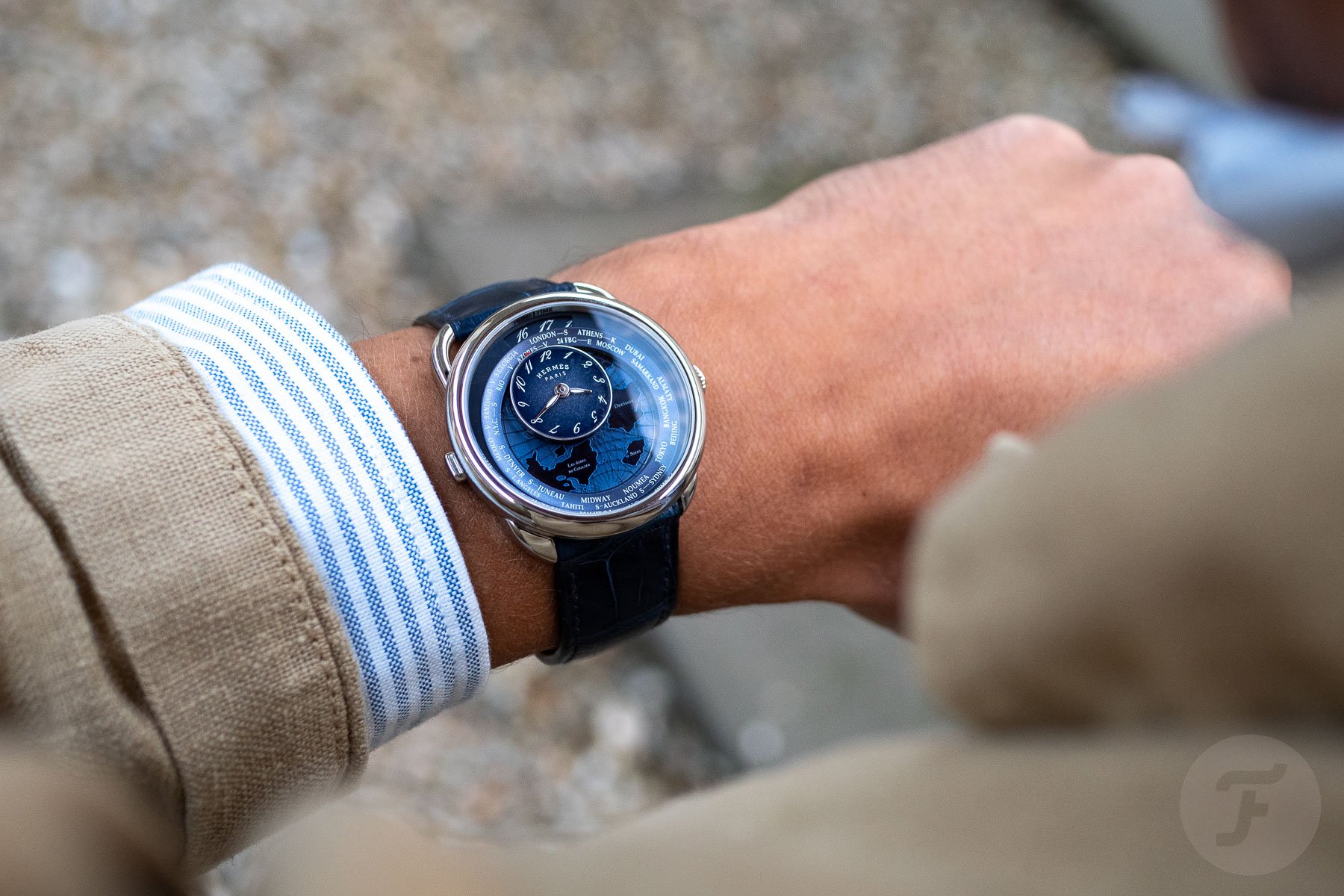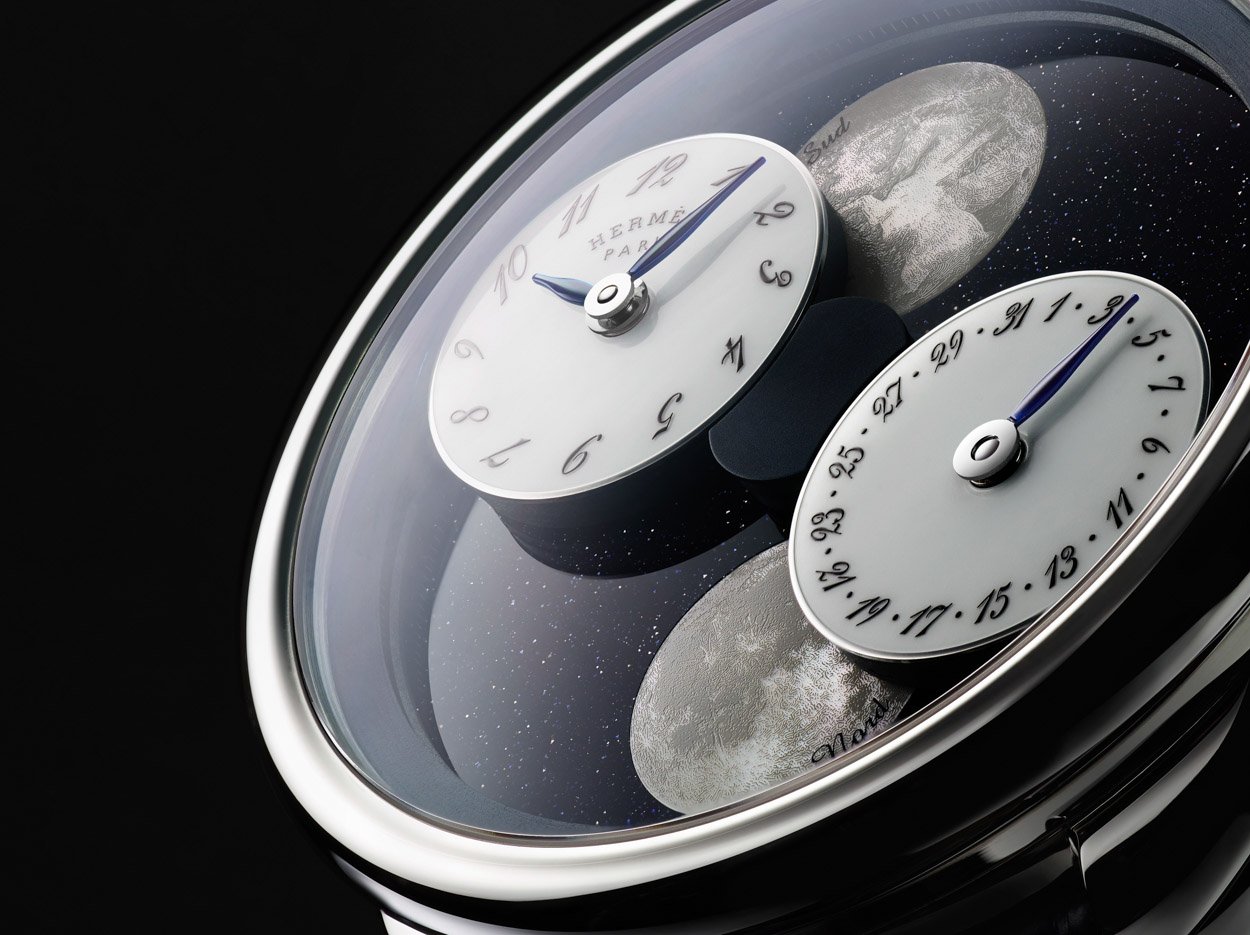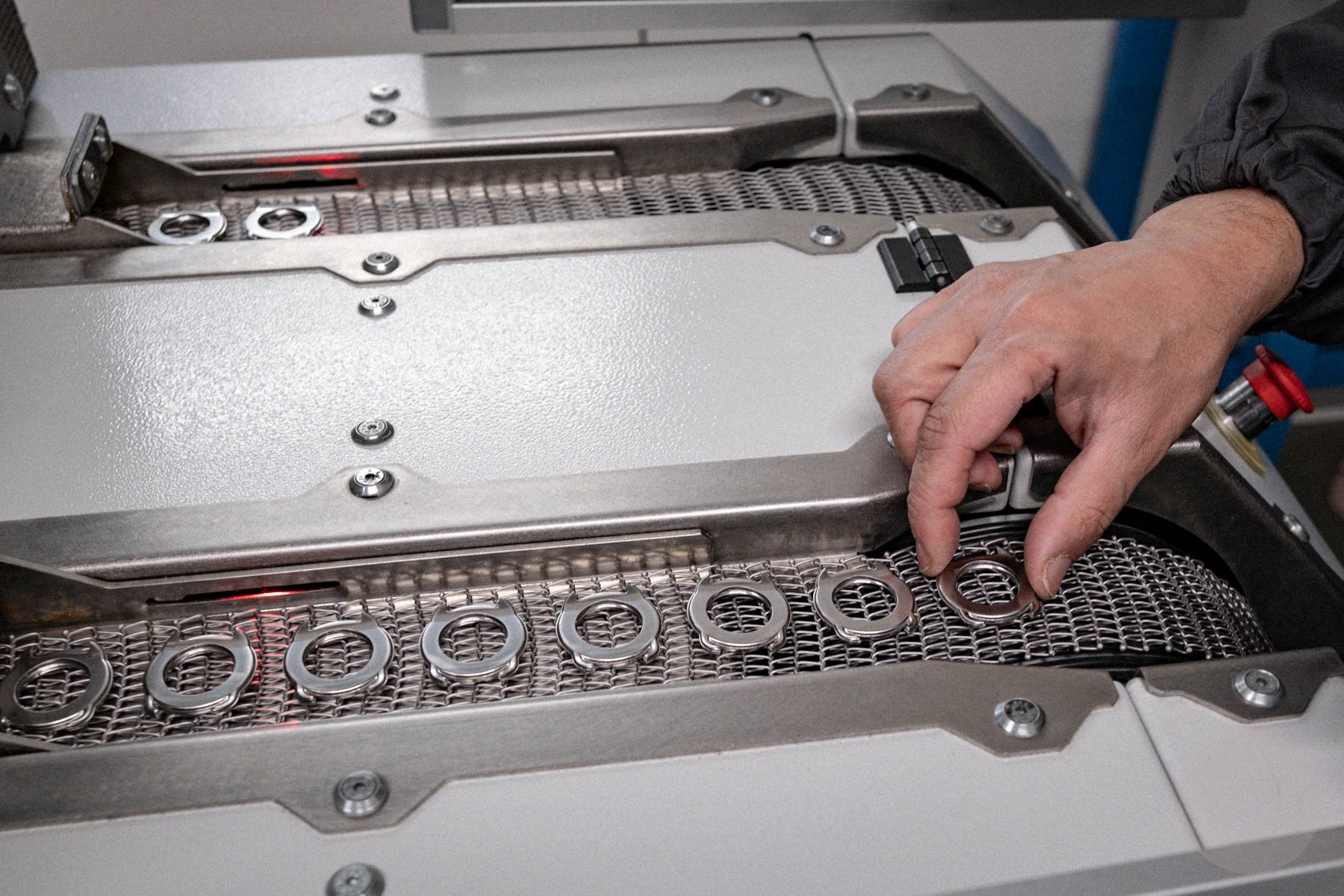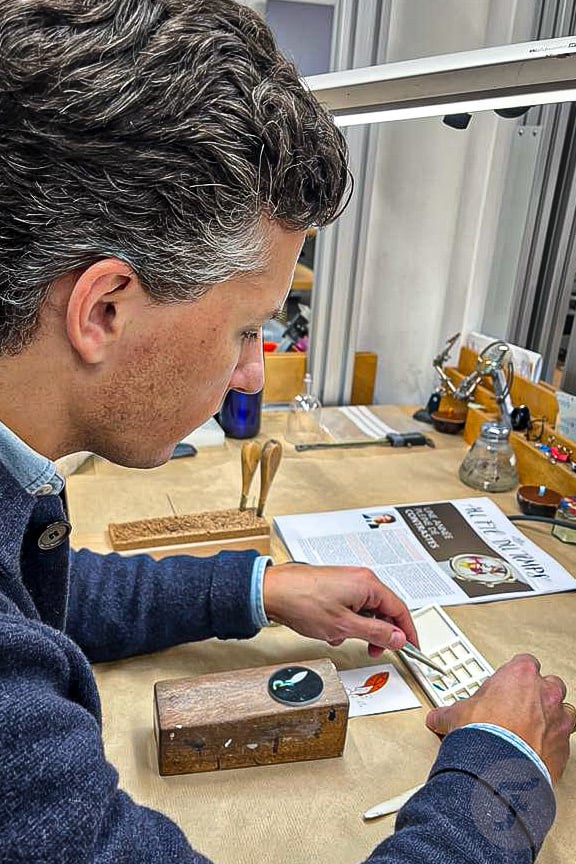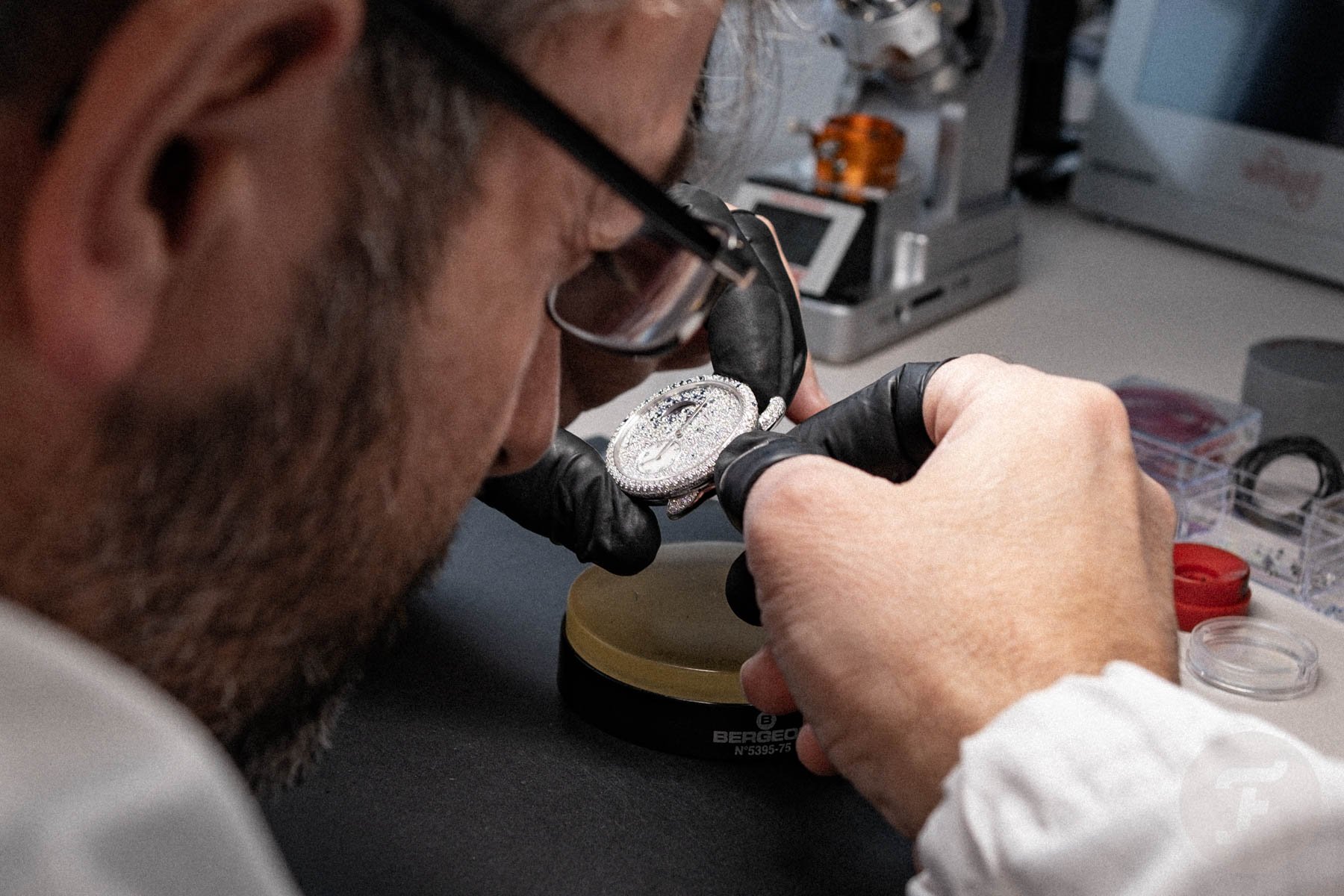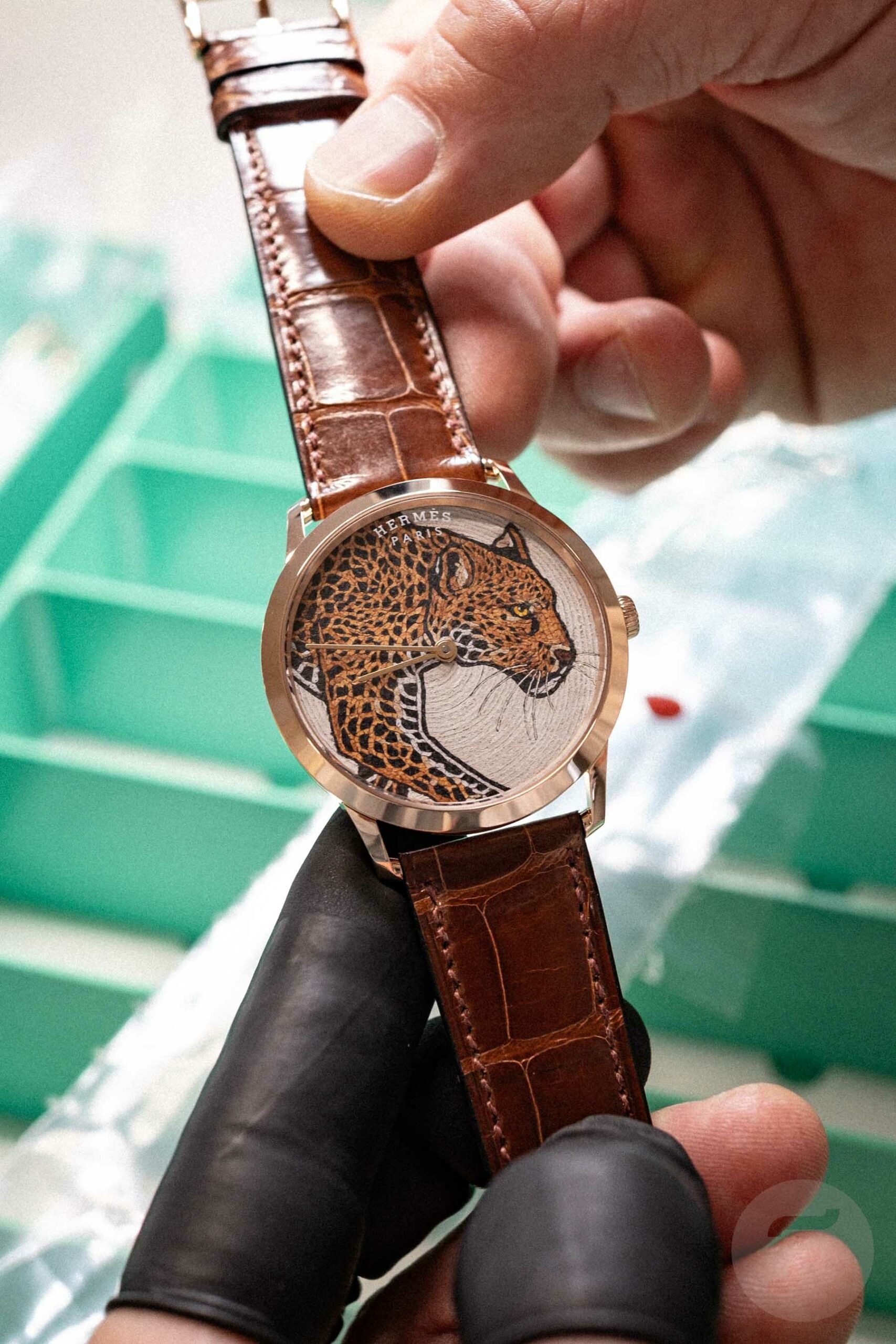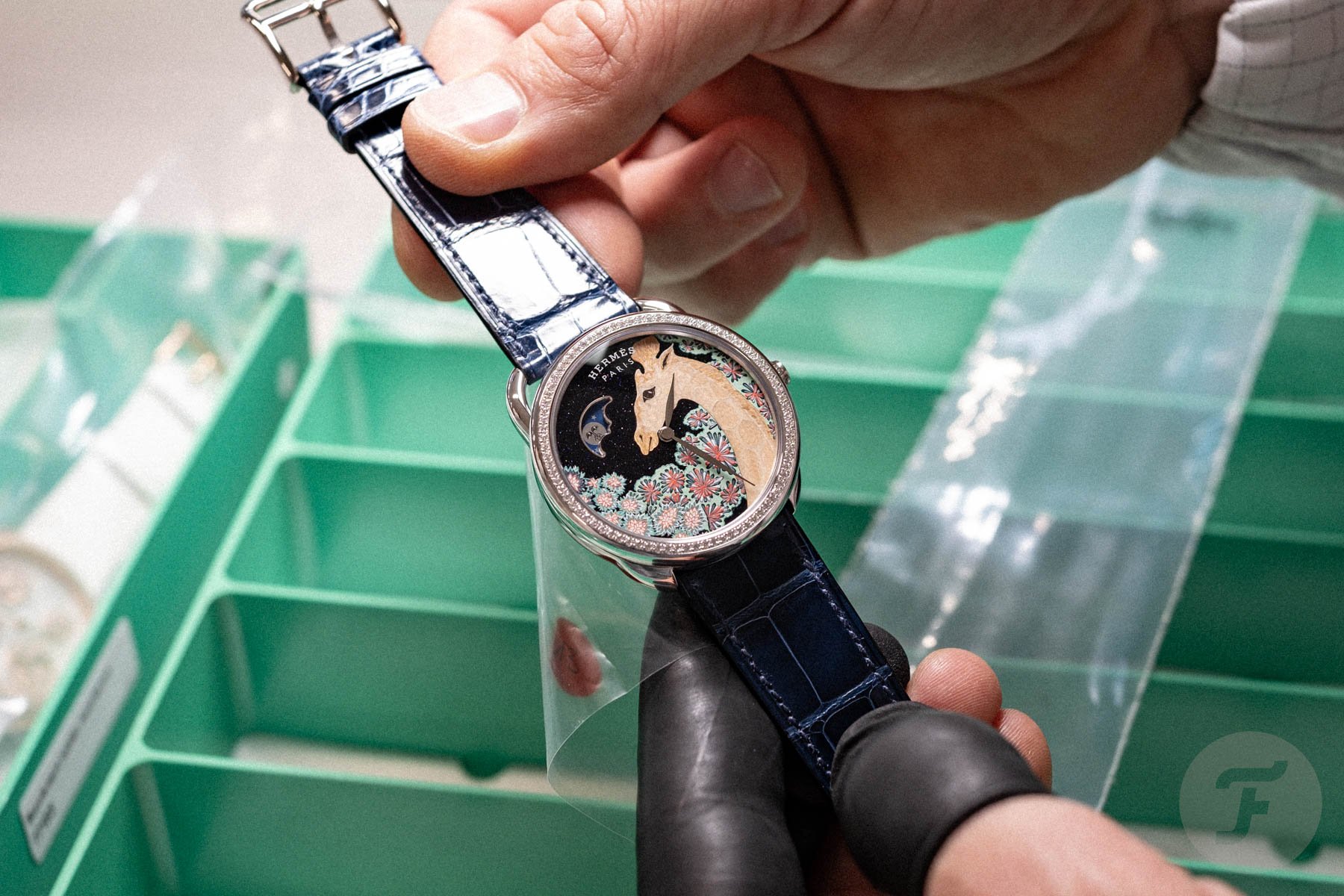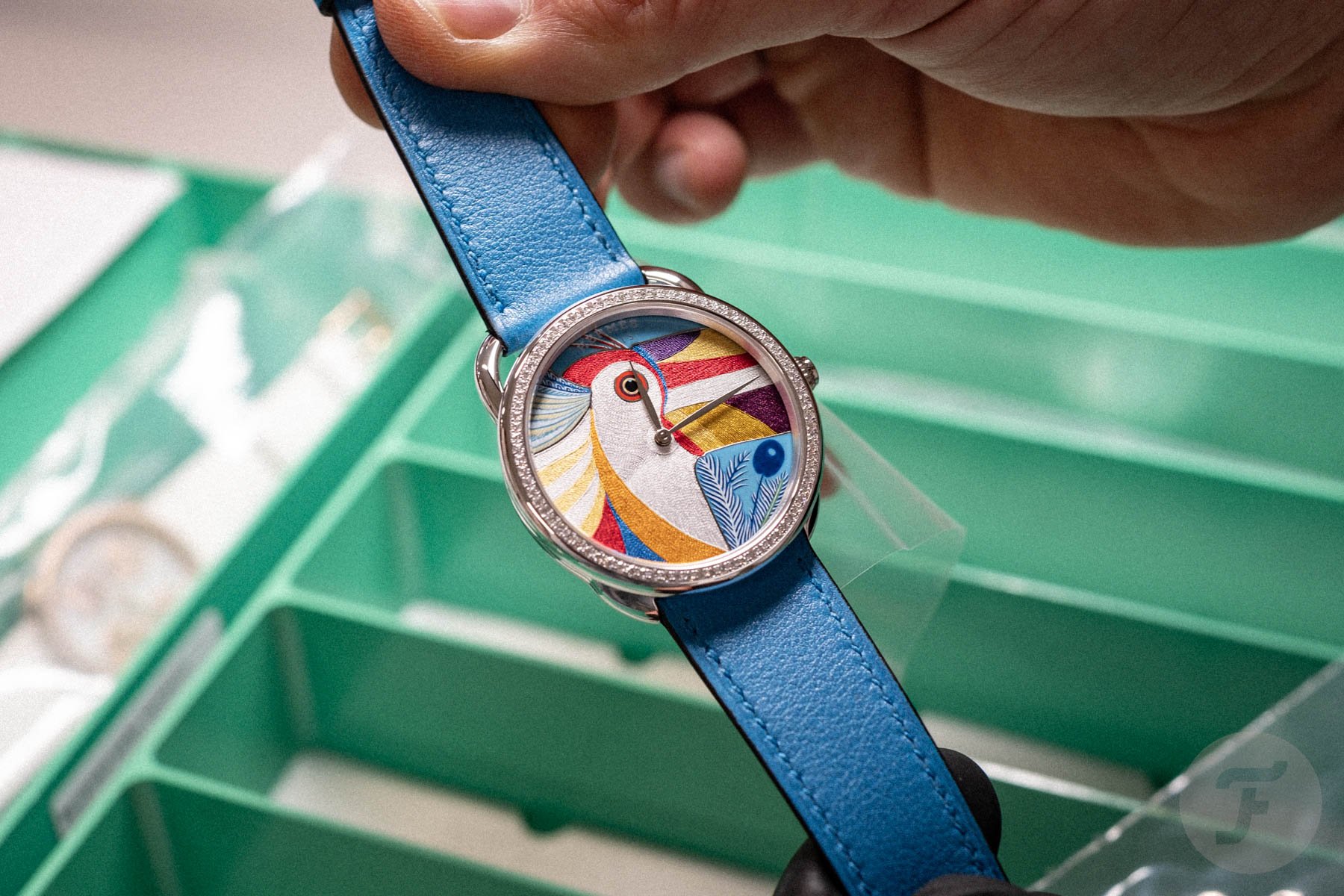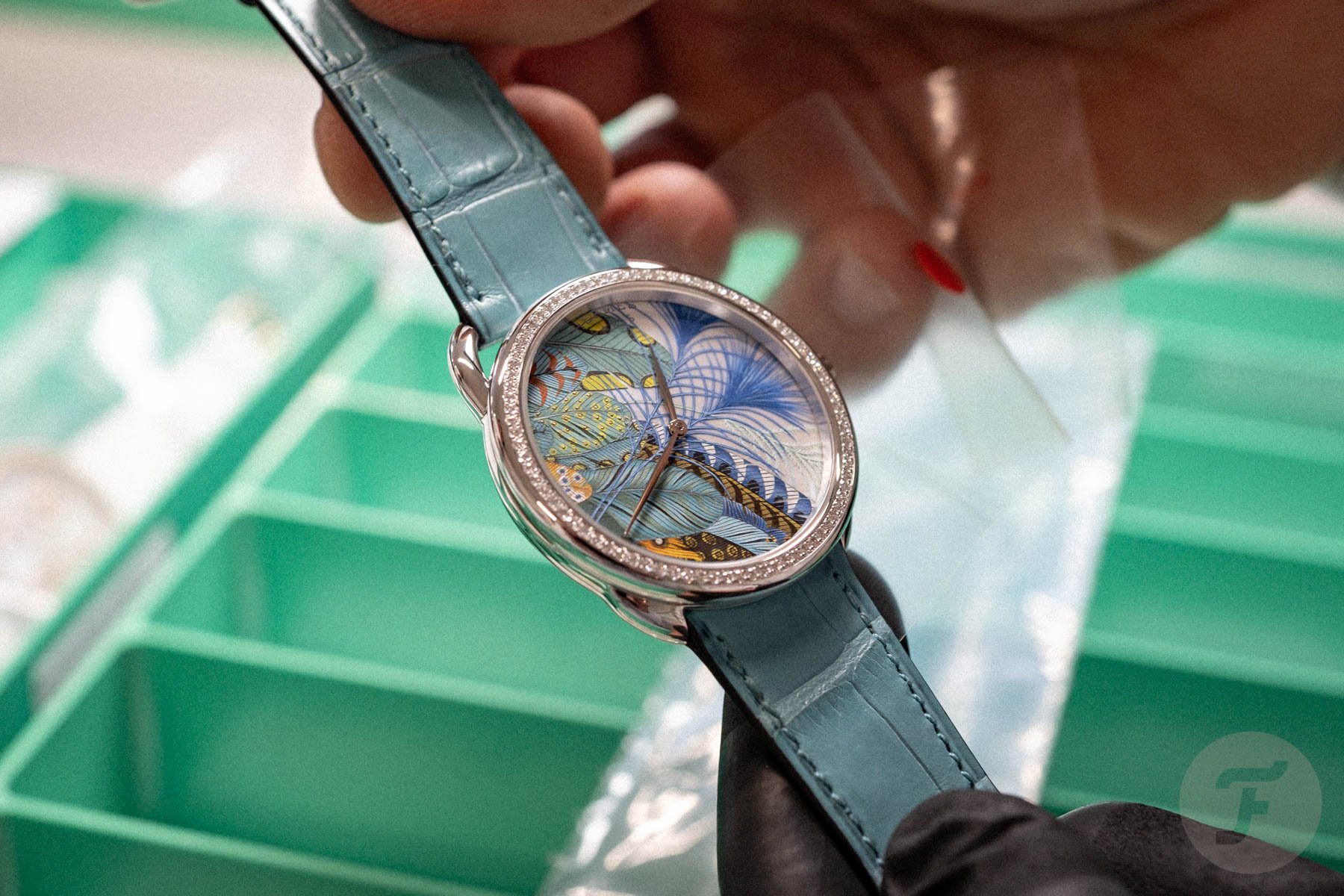A Visit To The Hermès Manufacture Shows That The Brand Takes Watchmaking Very Seriously
I know Hermès isn’t a brand you immediately associate with watchmaking. The French maison is better known for its high-quality leather goods and silk scarves. However, the brand’s watches with striking designs, such as those in the H08 and the Arceau collections, certainly stand out from the crowd. I was invited to take a look behind the scenes at the Hermès manufacture. There, it became clear to me that the same care and attention that go into designing the watches are also present when making them.
The first Hermès watch was made as early as 1912. Actually, it was more like a pocket watch housed in a leather wrist strap. It was made as a gift for Emile Hermès’s daughter Jacqueline. It wasn’t until 1928 that the company started producing watches for the general public. Those first watches were made in collaboration with various other Swiss watch brands. Therefore, on the dials, you could often find both Hermès’s and the other brand’s names. But then, in 1978, Jean-Louis Dumas, Jacqueline’s son, established La Montre Hermès in Brügg, a municipality adjacent to Biel/Bienne in Switzerland. That’s the moment when Hermès started to get serious about watchmaking.
Building the infrastructure
It was also the year that creative director Henri d’Origny came up with the design for the Arceau, which is inspired by the shape of a stirrup. In the ’90s, Hermès introduced watches like the Cape Cod and Médor. At that time, the watches were mostly targeted towards women and often carried quartz movements. However, in 2003, Hermès started a close collaboration with Vaucher Manufacture Fleurier to source its mechanical movements. Shortly after, in 2006, Hermès decided to take a 25% stake in that company. The other part of Vaucher is owned by the Sandoz Family Foundation, which also owns Parmigiani Fleurier, among others.
That same year, Hermès also opened a leather workshop in the Brügg headquarters. This is the building where the watches are assembled and where the back office and functions like sales, communication, and supply chain are located.
Then, in 2012, the first proprietary Hermès movements — the H1837 and H1912 — rolled off the line at Vaucher. But to make watches, you not only need straps and movements but also cases and dials. That’s why, in 2012 and 2013, Hermès decided to buy two other historical partners — dial maker Natéber from La Chaux-de-Fonds and case manufacturer Joseph Érard, based in Le Noirmont. In 2016, the company decided to integrate both sites into one, and in 2017, Les Ateliers d’Hermès Horloger was inaugurated in Le Noirmont. From that moment on, the watchmaking at Hermès truly started to take off, with the introduction of watches like the Arceau l’Heure de la Lune in 2019 and the sporty H08 in 2021.
The visit
During my visit, I got a tour of the headquarters, including the leather and assembly workshops, and Les Ateliers d’Hermès Horloger, where the dials and cases are made. I only took a very quick picture of the outside of the headquarters since it was snowing quite heavily that morning. But you can already see that, unlike the Hermès boutiques, the building doesn’t look that extravagant or luxurious. I don’t even think there was any branding on the manufacturing site where the dials and cases are made. This isn’t that strange if you consider that there are also some very valuable materials inside. In that case, I guess it shouldn’t be too obvious who the building belongs to.
Case manufacturing
I’ll start at the case- and dial-manufacturing site in Le Noirmont. This is where all stainless steel cases are made from scratch. Titanium and gold cases are stamped and sourced by third parties, although the rest of the finishing process is done by Hermès. It’s impressive to see how the raw case shapes are cut out of large pieces of metal. After a few more cutting iterations, the cases are pressed into their final shape. Then, after further refinement in ovens and refinishing machines, the final brushing and polishing is done by hand. For a case like that of the Arceau, it takes up to 46 steps to produce the final product
After visual quality control and stamping or engraving of the case backs, the cases are put together with temporary screws. They then go into a bath where their water resistance is tested. If everything is in order, the cases are packed and ready to go to the assembly facility in Brügg.
My guide, who’s the head of the case-making facility, already worked there before Hermès took over. He told me that Hermès is much more demanding than his former clients. Whenever a design comes from the creative department, he and his team can’t refuse based on technical feasibility. They simply have to make it work. On the other hand, they also get the time and the resources to make it work. But still, he said, it’s always a challenge to make those beautiful designs come to life.
Dial manufacturing
The same demands and expectations apply to the dial-making facility. It’s located on the same floor as the case-making department, and some rooms are even shared between the two. This also means the two teams can work closely together to overcome challenges. The majority of the dials start as simple pieces of brass. They are cut out to the right size and polished and brushed to get the desired finish.
For the coloring process, in the case of galvanic blue dials, they are put in an acidic bath for a certain amount of time. The longer they spend in it, the darker they become. The operator told me that in the beginning, he needed a stopwatch to know when to take the dials out. Nowadays, he simply knows when to take them out based on his experience. Other dials don’t receive their color by oxidation but rather by adding another layer on top, as happens during electroplating. After achieving the right color, the dials receive another polish or brush until they have precisely the right finish and feel.
Many of Hermès’s dials consist of multiple layers — think, for example, about the Arceau Le Temps Voyageur. All of those sub-dials and layers need to be in sync. The colors should match perfectly, and all the illustrations and printing have to be applied in exactly the right spots. One small imperfection could mean starting the whole process all over again.
Finally, the overlays, such as minute tracks and numerals, are applied to the dials. Hermès even makes the numerals in-house these days, which isn’t always easy. In particular, applying just the right amount of lume at such a small scale is a big challenge. Finally, it’s magnificent to see how those tiny little numerals are soldered onto the dial.
The leather workshop
You might also be familiar with the more extravagant dials that Hermès makes — for example, the ones with hand-painted flowers combined with a giraffe made out of a thin slice of wood or dials completely covered in silk. Sometimes, those dials require the skills of specific artisans who are hired for a specific job, like hand-painting. But other jobs, such as laying a mosaic of minuscule pieces of leather on a very small scale, are done in the leather workshop in the basement of the Hermès headquarters in Brügg.
We started in a big room where all the high-quality leather skins were stored. Once the craftsperson knows which skin and color to use, the required pieces are roughly cut out. The bottom of the leather is then shaved off to achieve the correct thinness. After all the pieces are cut to exactly the right size, the fully manual assembly process can start.
First, the various parts are glued and stitched together. Then, the edges must be sanded, heated, waxed, and sealed with the right amount of paint. The keepers go through the very same process, as you can see, the difference is in the details.
Leather dials
As I mentioned, Hermès doesn’t just make leather straps. The maison also makes dazzling dials from thousands of tiny pieces of leather. Sometimes, those tiny pieces are cut into specific shapes and, together, resemble a design from one of Hermès’s famous scarves. But there are also dials on which each tiny piece of leather has precisely the same square shape. The brand’s artisans put those pieces together as a mosaic to form, for example, a horse’s or tiger’s head.
While I was there, they let me try to put a leather marquetry together myself. It was a very simplified version of what they are used to themselves. Still, I just can’t express how challenging it was and how much patience and concentration you need to get it right and not mess it up in the process.
The assembly workshop
Finally, when all the components — the case, dial, strap, and movement — are finished, they are sent to the assembly workshop, which is also located at the headquarters in Brügg. There, the dial is applied on top of the movement, the hands are attached with the utmost precision, and, finally, the ensemble is encased.
Then, the case is checked again for water resistance, the movement is regulated, and its accuracy and power reserve are put to the test. After a final check, the strap or bracelet is attached, and the watch is made ready for shipment to the boutique where it was or will be sold.
It’s amazing to think about all the people who have worked on completing all the components. When you see the watches there, all nice and assembled, you don’t realize how many hands have touched them before they look like this.
Final thoughts
This wasn’t my first manufacture visit. I have seen other assembly workshops and movement manufacturers. But this was the first time that I witnessed how cases, dials, and straps were made completely from scratch. It’s impressive to see how Hermès has acquired and completely mastered these skills. Moreover, the brand has adjusted these capabilities completely to its will to create exactly what designers like Philippe Delhotal envision.
The way Hermès has built its ateliers is impressive. Furthermore, getting a close-up look at the maison’s way of not cutting any corners tells me that it is taking watchmaking very seriously. When it comes to the cases and dials, almost everything happens in-house. Even the movements are made by a party that’s partly owned by Hermès. There aren’t many brands out there that can say the same thing.
Of course, I would’ve loved also to see the Vaucher manufacture and maybe even take a look at Chronode. That’s the company with which Hermès develops some of the modules on top of its movements, for example, the one for the Arceau Le Temps Voyageur. But that, at least, leaves something to the imagination. And who knows? Maybe one day…
I’d like to hear your thoughts about Hermès as a watch brand. Has the report of this visit to the Hermès manufacture changed your feelings in any way? Let me know in the comments below.

